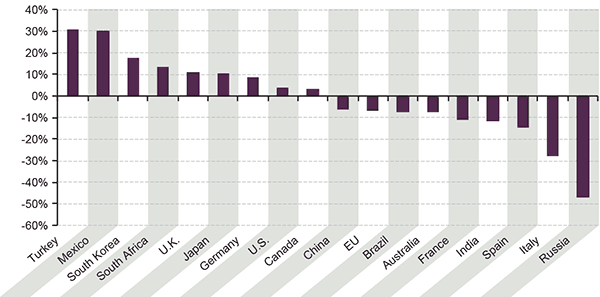While U.S. stocks are increasingly due for a consolidation, the outlook for global equities is improving. Now appears to be a good time for investors to increase allocations toward Asia and Europe.
U.S. equities have become further extended, and there is a risk that the increasing economic headwinds could negatively affect earnings and share prices as the end of the year approaches. Additionally, the United States faces ongoing uncertainty over monetary policy and increasing concern in Washington about a possible government shutdown. With only three months remaining in 2013, a rebound in economic growth does not appear likely before the first or second quarter of 2014. The outlook for the economies and markets of Asia and Europe, however, appears much more positive, which the current decrease in U.S. interest rates will only reinforce.
Continued U.S. monetary stimulus is good news for Asian and particularly Chinese stocks, the valuations of which have been battered down to levels not seen since 2006. The bearish view holds that China has done little to address its structural problems. However, the same argument could have been made about the United States in 2009, at the outset of a rally that saw equities rise by 151 percent to their current historical highs. Importantly, in the near-term, Chinese economic data (including the recent purchasing managers and industrial production numbers) is showing cyclical improvement.
In Europe, Chancellor Angela Merkel’s re-election in Germany and the announcement by European Central Bank President Mario Draghi that more long-term refinancing could be available for banks bode well for economic recovery. Although headwinds remain, Europe has established a fairly sound base and lower interest rates should mean the continent’s recent economic momentum will pick up. This will almost certainly translate into higher prices for European stocks, which have a great deal of headroom.
It appears that Asia and Europe will be the biggest winners from the U.S. Federal Reserve’s decision to maintain extreme monetary accommodation. Investors should consider using strength in U.S. indices to lighten up domestic positions and gain greater exposure to overseas markets. The all-clear signals coming out of those regions indicate non-U.S. stocks have a great deal of potential upside for at least the next three to six months.
European, BRICs Stocks Undervalued
A country’s market capitalization as a percent of GDP is a useful indicator in assessing whether an equity market is under- or overvalued. Making direct comparisons between developed markets and emerging markets can be difficult, however, because the latter tend to have less developed stock markets and lower market capitalization to GDP ratios. A more useful indicator is to compare a country’s ratio to its historic levels. Based on current differences from previous 10 year averages, European markets, especially Italy, Spain, and France, appear particularly undervalued and therefore attractive. Additionally, the BRICs (Brazil, Russia, India, China) countries are currently below their averages, suggesting now may be a good buying opportunity.
MARKET CAPITALIZATION, % OF GDP: DEVIATION FROM PRIOR 10-YEAR AVERAGE

Source: Bloomberg, Haver Analytics, Guggenheim Investments. Data as of Q2 2013.
This material is distributed for informational purposes only and should not be considered as investing advice or a recommendation of any particular security, strategy or investment product. This article contains opinions of the author but not necessarily those of Guggenheim Partners or its subsidiaries. The author’s opinions are subject to change without notice. Forward looking statements, estimates, and certain information contained herein are based upon proprietary and non-proprietary research and other sources. Information contained herein has been obtained from sources believed to be reliable, but are not assured as to accuracy. No part of this article may be reproduced in any form, or referred to in any other publication, without express written permission of Guggenheim Partners, LLC. ©2013, Guggenheim Partners. Past performance is not indicative of future results. There is neither representation nor warranty as to the current accuracy of, nor liability for, decisions based on such information. Past performance is not indicative of future results. There is neither representation nor warranty as to the current accuracy of, nor liability for, decisions based on such information.

